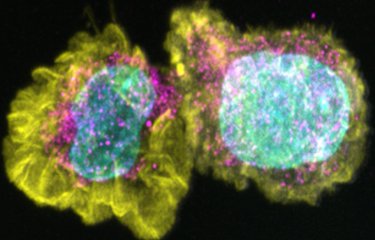Scientists at the Institut Pasteur and their partners in the international TBVAC2020 consortium have just developed a tuberculosis vaccine candidate derived from conventional BCG. This vaccine candidate has higher efficacy, due to a heterologous system of protein secretion that increases the quality and magnitude of the immune responses to virulent strains of Mycobacterium tuberculosis – the bacterium responsible for the disease. These promising results were published in Cell Reports on March 14, 2017.
Tuberculosis is a chronic infection caused by the Mycobacterium tuberculosis bacterium. It is responsible for 1.8 million deaths annually (WHO figures for 2015), and still ranks among the ten leading causes of death globally. The BCG vaccine consists of an attenuated strain of Mycobacterium bovis, and is considered effective in children, although it does not provide sufficient protection for adults – particularly against pulmonary tuberculosis, which is the most infectious form. The development of a vaccine providing better protection against tuberculosis therefore remains one of the primary objectives in terms of controlling the disease.
Scientists at the Institut Pasteur have for several years been able to highlight mechanisms that characterize the interaction of M. tuberculosis with the host's immune cells. During infection the bacterium uses a specialized secretion system known as ESX-1 to compromise the integrity of the vacuole membrane of the host cell in which it is enclosed. Subsequent rupture of this membrane brings the mycobacterial components into contact with the cytosol of host cell. This is the signal for triggering a series of innate immune responses contributing to the control of mycobacterial growth. Due to a deletion of a chromosomal region, BCG lacks the ESX-1 secretion system. Its protective action is therefore not based on this powerful cascade of innate immune responses.
This prompted scientists at the Unit for Integrated Mycobacterial Pathogenomics at the Institut Pasteur, led by Roland Brosch, to explore this new avenue with the aim of developing a more effective vaccine candidate than BCG, based on the concept that restoring these innate immune responses to a vaccine strain may improve immunogenicity. By expressing the ESX-1 secretion system of Mycobacterium marinum, a low-virulence aquatic mycobacterium, they constructed a recombinant BCG strain able to induce the same type of immune response as M. tuberculosis. "The key mechanism is the contact established between the bacterial components and cytosol – which is found inside the host cell. Conventional BCG remains imprisoned in a vacuole and does not communicate to any great extent with the host cell cytosol", explained Roland Brosch. The innate and adaptive immune responses achieved with the new strain are qualitatively and quantitatively enhanced and result in improved recognition of mycobacterial antigens. The virulence of the strain produced in this way is also attenuated, which makes it a promising vaccine candidate. Mice vaccinated with this strain have shown better protection against subsequent infection by M. tuberculosis than mice vaccinated with conventional BCG.
These results were published in Cell Reports, and offer new possibilities for the development of a more effective vaccine against the various pathologies caused by M. tuberculosis, in particular pulmonary tuberculosis in adults. Further experiments are being carried out with a view to future clinical developments, including human trials. "We have filed a patent relating to this strain, with the objective of moving on to clinical trials in the future," Roland Brosch was pleased to announce.
This research was funded by the European Union (via the TBVAC2020 consortium), the French Medical Research Foundation (FRM), and the Integrative Biology of Emerging Infectious Diseases (IBEID) Laboratory of Excellence managed by the French National Research Agency.
Source
Recombinant BCG Expressing ESX-1 of Mycobacterium marinum Combines Low Virulence with Cytosolic Immune Signaling and Improved TB Protection, Cell Reports, 14 mars 2017. http://dx.doi.org/10.1016/j.celrep.2017.02.057.
Matthias I. Gröschel (1,2), Fadel Sayes (1), Sung Jae Shin (3), Wafa Frigui (1), Alexandre Pawlik (1), Mickael Orgeur (1), Robin Canetti (1), Nadine Honore (1), Roxane Simeone (1), Tjip S. van der Werf (2), Wilbert Bitter (4, 5), Sang-Nae Cho (3), Laleh Majlessi (1) and Roland Brosch (1, 6)*
(1) Unit for Integrated Mycobacterial Pathogenomics, Institut Pasteur, 75015 Paris, France
(2) Department of Pulmonary Diseases & Tuberculosis, University Medical Center Groningen, University of Groningen, 9700 RB Groningen, the Netherlands
(3) Department of Microbiology, Institute for Immunology and Immunological Diseases, Brain Korea 21 PLUS Project for Medical Science, Yonsei University College of Medicine, 03722 Seoul, South Korea
(4) Department of Medical Microbiology and Infection Control, VU University Medical Center, 1081 HZ Amsterdam, the Netherlands
(5) Section Molecular Microbiology, Amsterdam Institute of Molecules, Medicine and Systems, Vrije Universiteit Amsterdam,1081 HZ Amsterdam, the Netherlands
(6) Lead Contact





